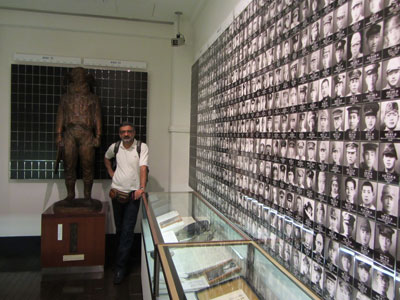Hiroshima travelogue - Part 4
We leave 'The Center of the Tokyo Raids and Was Damage' after taking several pictures with two symbols placed at the entrance door. Next, we head for Yūshūkan military museum in Tokyo. They drive to a different location. Someone says there is the emperor's house over the river and the long rampart we are passing. (What is going on in there? Only God would know.)
Meanwhile, many people are jogging along the pedestrian. Is this the same house where Mehdi Gholi Khan Hedayat accompanied with Ataback met with the Japanese emperor on December 20, 1903 (Ramadan 30, 1321 hg)? I don’t know, but I know that the Iranian Hedayat (Mokhber-o-Saltaneh), known as the globetrotter of his time, was as impressed with Japan as was his compatriot, Hedayatollah, almost 110 years later by seeing the [eastern Asian] country. The impression was not a primeval response to comparing the two countries (Iran and Japan), but stems from a historical question to which various answers have been proposed. Why have we [Iranians] slid back of progression, expansion of laws, institutionalization of social impeccability, exuding self-confidence, professional commitment, and, in a general manner, whatever needed for a better social life? And even if some steps have been taken, why have they been too feeble and unsteady? During these 110 years, four generations have come and gone and what strange events have passed! [The sad thing is that] we have failed to learn from the astonishing order of universe; we have ignored the nature's key to success; we have closed our eyes to the professional commitment of a bumble bee; we have forgotten we are God's greatest creature; ... Will some 110 years later, during another Ramadan, another Hedayat think about such questions? Heaven forbid!

They say these structures are called “Gates of godsâ€. We pass through one of them at the entrance of the museum. We get to a temple. They don’t focus a lot on the temple but many have attached their demands and wishes to it by ropes.
On my right, over the temple, is the museum. It is an official state-run museum. Here is procured everything needed for honoring Japanese comrades, especially those who sacrificed their lives in Kamikaze missions.
The building is relatively large and has numerous halls. It is tastefully arranged and decorated. Besides the display of old items dating back to WWII, the latest technological apparatus has been provided to show the history of the war to the visitors. The museum is a combination of the past life and modern technology.
The museum is established not to forget, but to remember the war; and exhibits no signs of regret or remorse. The whole establishment is constructed to review the heroic acts of Japanese comrades. They say if a Japanese official happens to visit the museum, they would be domestically and internationally censured for reminding the society of Japans' militarism and invasions.
In the end, I wrote a small note in the museum's notebook. This is its final sentence: I hope there will be no wars in the world and honors are not given to people for killing, but for giving life.
To be continued…
By Habibollah Behboudi
Translated into English by Abbas Hajihashemi
Number of Visits: 5274








The latest
- The 372nd Night of Memoires– Part 2
- Third Regiment: Memoirs of an Iraqi Prisoner of War Doctor – 8
- 100 Questions/7
- Managing Oral History Interviews
- The 372nd Night of Memories – Part 1
- Third Regiment: Memoirs of an Iraqi Prisoner of War Doctor – 7
- Objects Tell What Happened in the Eight-Year War!
- 100 Questions/6
Most visited
- Third Regiment: Memoirs of an Iraqi Prisoner of War Doctor – 7
- Comparative Analysis of Women’s and Men’s Written Memoirs in the Sacred Defense
- 100 Questions/6
- Objects Tell What Happened in the Eight-Year War!
- The 372nd Night of Memories – Part 1
- Managing Oral History Interviews
- 100 Questions/7
- Third Regiment: Memoirs of an Iraqi Prisoner of War Doctor – 8
Comparing the Narratives of Commanders and Ordinary Combatants in the Sacred Defense
An Analysis of Functions and ConsequencesThe experience of the Sacred Defense cannot be comprehended merely through statistics or official reports; what truly endures from war are the narratives of those who stood upon its frontlines. These narratives, however, vary significantly depending on one’s position, responsibilities, and lived experience.
Unveiling of the book "Oral History: What and Why"
The First report: Alireza KamariAccording to the Oral History website, the unveiling ceremony of the book "Oral History: What and Why" by Hamid Qazvini was held on Sunday evening, November 24, 1404, in the presence of experts in the field of oral history in the Salman Farsi Hall of the Arts Center.
Mohammad — The Messiah of Kurdistan
Boroujerdi immediately said to Darvish, “Ready a few men; we’re going.” Then he moved toward Mostafa, who was studying the Kurdistan map. Mostafa straightened his back and said, “During my service in the army I experienced a full-scale war in Kurdistan. Guerrilla warfare in Kurdistan follows its own rules. The anti-revolutionary commanders want to draw us into a battle chosen on their terms.”

